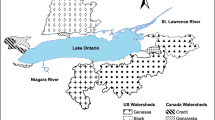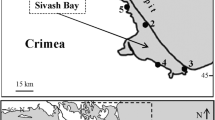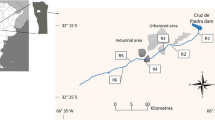Abstract
A study was undertaken to assess the extent of mercury contamination in the water and sediment in a seasonal wetland, as well as to determine the relationship between environmental parameters and the distribution of the mercury contamination. Water and sediment samples were collected and analysed for methylmercury, inorganic mercury and other physical and chemical variables. One-way analysis of variance and homogeneity of variance were performed, and linear regression analysis was used to determine correlations between mercury and other environmental variables. The highest mercury concentrations were recorded at the sites located closest to the industrial complex. Methylmercury concentrations in the water and sediment were mostly higher during the low flow season, while inorganic mercury concentrations in the water and sediment were higher during the high flow and low flow seasons, respectively. Chromium, manganese, organic carbon and fine sediment particles were found to have significantly positive correlations with mercury concentrations in water and sediment. It was also found that the mercury concentrations decreased within a relatively short distance from the sites closer to the industrial complex to the sites further downstream.





Similar content being viewed by others
References
Allan, R. J. (1979). Sediment-related fluvial transmission of contaminants: some advances by 1979. Scientific Series Number 107. Canada: Inland Waters Directorate. Environment Canada.
Andersson, I., Parkman, H., & Jernelov, A. (1990). The role of sediments as sink or source for environmental contaminants: a case study of mercury and chlorinated organic compounds. Limnologica, 20, 347–359.
ANZECC, & ARMCANZ (2000) Australian and New Zealand Guidelines for Fresh and Marine Water Quality. National Water Quality Management Strategy, vol. 1–2. Australian and New Zealand Environment and Conservation Council and the Agriculture and Resource Management Council of Australia and New Zealand. Canberra: Australia.
Balogh, S. J., Swain, E. B., & Nollet, Y. (2006). Elevated methylmercury concentrations and loadings during flooding in Minnesota rivers. Science of the Total Environment, 368, 138–148.
Balogh, S. J., Swain, E. B., & Nollet, Y. H. (2008). Characteristics of mercury speciation in Minnesota rivers and streams. Environmental Pollution, 154, 3–11.
Beckvar, N., Field, J., Salazar, S., & Hoff, R. (1996). Contaminants in aquatic habitats at hazardous waste sites: mercury. NOAA Technical Memorandum NOS ORCA 100. Seattle: Hazardous Materials Response and Assessment Division, National Oceanic and Atmospheric Administration. 74 pp.
Benoit, J. M., Gilmour, C. C., & Mason, R. P. (2001). The influence of sulfide on solid-phase mercury bioavailability for methylation by pure cultures of Desulfobulbus propionicus (1pr3). Environmental Science and Technology, 35, 127–132.
Benoit, J. M., Gilmour, C. C., Mason, R. P., & Heyes, A. (1999). Sulfide controls on mercury speciation and bioavailability to methylating bacteria in sediment pore waters. Environmental Science and Technology, 33, 951–957.
Bishop, K. H., & Lee, Y.-H. (1997). Catchments as a source of mercury/methylmercury in boreal surface waters. In A. Sigel & H. Sigel (Eds.), Metal ions in biological systems. Mercury and its effects on environment and biology. Volume 34. New York: Marcel Dekker, Inc.
Cid, B. P., Gonzalez, M. D., & Gomez, E. F. (2002). Comparison of single extraction procedures, using either conventional shaking or microwave heating, and the Tessier sequential extraction method for the fractionation of heavy metals from environmental samples. Analyst, 127, 681–688.
DEC. (1999). Technical guidance for screening contaminated sediments. New York: Division of Fish, Wildlife and Marine Resources.
DWAF. (1992). Analytical methods manual. Technical report 151. Pretoria: Department of Water Affairs and Forestry.
Dodds, W. K., Jones, J. R., & Welch, E. B. (1998). Suggested classification of stream trophic state: distributions of temperate stream types by chlorophyll, total nitrogen, and phosphorous. Water Research, 32, 1455–1462.
EPA. (1986). Quality criteria for water. EPA report 440/5-86-001. USA: United States Environmental Protection Agency.
Canada, E. (2005). Canadian water quality guidelines: inorganic mercury and methylmercury. Ottawa: National Guidelines and Standards Office.
Fitzgerald, W. F., Engstrom, D. R., Mason, R. P., & Nater, E. A. (1998). The case for atmospheric mercury contamination in remote areas. Environmental Science and Technology, 32, 1–7.
Fontanella, M. C., Ravera, O., Befone, G. M., Riccardi, N., & Cattani, I. (2009). Mercury distribution in the main compartments of the eutrophic Lake Candia (Northern Italy). Journal of Limnology, 68(2), 352–358.
Förstner, U., & Wittman, G. T. W. (1979). Metal pollution in the aquatic environment. Berlin: Springer.
Fostier, A. H., Falótico, M. B., Ferraz, E. S. B., Tomazelli, A. C., Salomão, M. S. M. B., & Martinelli, L. A. (2005). Impact of anthropogenic activity on the Hg concentrations in the Piracicaba river basin (São Paulo State, Brazil). Water, Air, and Soil Pollution, 165, 371–392.
Fytianos, K., & Lourantou, A. (2004). Speciation of elements in sediment samples collected at lakes Volvi and Koronia, N. Greece. Environment International, 30, 11–17.
Galloway, M. E., & Branfireun, B. A. (2004). Mercury dynamics of a temperate forested wetland. Science of the Total Environment, 325, 239–254.
Gill, G. A., & Bruland, K. W. (1990). Mercury speciation in surface freshwater systems in California and other areas. Environmental Science and Technology, 24, 1392–1400.
Gilmour, C. C., & Henry, E. A. (1991). Mercury methylation in aquatic systems affected by acid deposition. Environmental Pollution, 71, 131–169.
Gilmour, C. C., Henry, E. A., & Mitchell, R. (1992). Sulfate stimulation of mercury methylation in freshwater sediments. Environmental Science and Technology, 26, 2281–2287.
Graf, W. L. (1985). Mercury transport in stream sediments of the Colorado Plateau. Annals of the Association of American Geographers, 75, 552–565.
Graham, M., & Louw, M. D. (2009). River ecoclassification. Manual for ecostatus determination version 2. Module G: index of habitat integrity. Section 2: model photo guide. WRC Report No. TT 378/09. Pretoria: Water Research Commission.
Grigal, D. F. (2002). Inputs and outputs of mercury from terrestrial watersheds: a review. Environmental Reviews, 10, 1–39.
Hellawell, J. M. (1986). Biological indicators of freshwater pollution and environmental management. London: Elsevier Applied Science Publishers.
Heyes, A., Mason, R. P., Kim, E.-H., & Sunderland, E. (2006). Mercury methylation in estuaries: insights from using measuring rates using stable mercury isotopes. Marine Chemistry, 102, 134–147.
Horowitz, A. J. (1985). A primer on trace metal-sediment chemistry. United States Geological Survey Water Supply Paper 2277. Alexandria: US Geological Survey.
Horvat, M., Liang, L., & Bloom, N. S. (1993). Comparison of distillation with other current isolation methods for the determination of methyl mercury compounds in low level environmental samples. Part II Water. Analytica Chimica Acta, 282, 153–168.
Horvat, M., Nolde, N., Fajon, V., Jereb, V., Logar, M., Lojen, S., et al. (2003). Total mercury, methylmercury, and selenium in mercury polluted areas in the province Guizhou, China. Science of the Total Environment, 304, 231–256.
Hudson, R. J. M., Gherini, S. A., Watras, C. J., & Porcella, D. B. (1994). Modeling the biogeochemical cycle of mercury in lakes: the mercury cycling model (MCM) and its application to the MTL study lakes. In C. J. Watras & J. W. Huckabee (Eds.), Mercury pollution, integration and synthesis. Boca Raton: Lewis Publishers.
Jackson, T. A. (1997). Long-range atmospheric transport of mercury to ecosystems, and the importance of anthropogenic emissions—a critical review and evaluation of the published evidence. Environmental Reviews, 5, 99–120.
Kannan, K., Smith, R. G., Jr., Lee, R. F., Windom, H. L., Heitmuller, P. T., Macauley, J. M., et al. (1998). Distribution of total mercury and methyl mercury in water, sediment, and fish from South Florida estuaries. Archives of Environmental Contamination and Toxicology, 34, 109–118.
Kelly, C. A., Rudd, J. W. M., St. Louis, V. L., & Heyes, A. (1995). Is total mercury concentration a good predictor of methyl mercury concentration in aquatic systems? Water, Air, and Soil Pollution, 80, 715–724.
Krabbenhoft, D. P., Branfireun, B. A., & Heyes, A. (2005). Biogeochemical cycles affecting the speciation, fate and transport of mercury in the environment. In M. B. Parsons & J. B. Percival (Eds.), Mercury: sources, measurements, cycles, and effects. Short course series. Volume 34. Ottawa: Mineralogical Association of Canada.
Lambertsson, L., & Nilsson, M. (2006). Organic material: the primary control on mercury methylation and ambient methyl mercury concentrations in estuarine sediments. Environmental Science and Technology, 40, 1822–1829.
Leaner, J. J., Dabrowski, J. D., Mason, R. P., Resane, T., Richardson, M., Ginster, M., et al. (2009). Mercury emissions from point sources in South Africa. In N. Pirrone & R. Mason (Eds.), Mercury fate and transport in the global atmosphere: measurements, models and policy implications. New York: Springer.
Leeu-Taaibosspruit Forum (2003). In-stream water quality guidelines for the Taaibosspruit catchment. http://www.reservoir.co.za. Accessed 7 Mar 2013.
Liang, L., Bloom, N. S., & Horvat, M. (1994). Simultaneous determination of mercury speciation in biological materials by GC/CVAFS after ethylation and room-temperature precollection. Clinical Chemistry, 40, 602–607.
Liang, L., & Horvat, M. (1996). A simple solvent extraction technique for elimination of matrix interferences for determination of methylmercury by GC/CVAFS after ethylation. Talanta, 43, 1883–1888.
Logar, M., Horvat, M., Falnoga, I., & Stibilj, V. (2000). A methodological study of mercury speciation using dogfish liver CRM (DOLT-2). Fresenius' Journal of Analytical Chemistry, 366, 453–460.
Long, E. R., & Morgan, L. G. (1990). The potential for biological effects of sediment-sorbed contaminants tested in the national states and trends program. National Oceanic Atmospheric Administration (NOAA). Technical memorandum number 5. Seattle: OMA52, NOAA National Ocean Service.
Lorenzen, C. J. (1967). Determination of chlorophyll and pheo-pigments: spectrophotometric equations. Limnology and Oceanography, 12, 343–346.
Marvin-Dipasquale, M., Lutz, M. A., Brigham, M. E., Krabbenhoft, D. P., Aiken, G. R., Orem, W. H., et al. (2009). Mercury cycling in stream ecosystems. 2. Benthic methylmercury production and bed sediment-pore water partitioning. Environmental Science and Technology, 43, 2726–2732.
Matilainen, T., Verta, M., Niemi, M., & Uusi-Rauva, A. (1991). Specific rates of net methylmercury production in lake sediments. Water, Air, and Soil Pollution, 56, 595–605.
Mehrotra, A. S., & Sedlak, D. L. (2005). Decrease in net mercury methylation rates following iron amendment to anoxic wetland sediment slurries. Environmental Science and Technology, 39, 2564–2570.
Miller, J., Barr, R., Grow, D., Lechler, P., Richardson, D., Waltman, K., et al. (1999). Effects of the 1997 flood on the transport and storage of sediment and mercury within the Carson River Valley west-central Nevada. Journal of Geology, 107, 313–327.
Moore, J. W., & Ramamoorthy, S. (1984). Heavy metals in natural waters. New York: Springer.
Morel, F. M. M., Draepiel, A. M. L., & Amyot, M. (1998). The chemical cycle and bioaccumulation of mercury. Annual Review of Ecology and Systematics, 29, 543–566.
Nater, E., & Grigal, D. (1992). Regional trends in mercury distribution across the Great Lakes states, north central USA. Nature, 358, 139–141.
Olson, B. H., & Cooper, R. C. (1976). Comparison of aerobic and anaerobic methylation of mercuric chloride by San Francisco Bay sediments. Water Research, 10, 113–116.
Orihel, D. M., Paterson, M. J., Blanchfield, P. J., Bodaly, R. A., Gilmour, C. C., & Hintelmann, H. (2008). Temporal changes in the distribution, methylation, and bioaccumulation of newly deposited mercury in an aquatic ecosystem. Environmental Pollution, 154, 77–88.
Pacyna, J. M., Pacyna, E. G., Steenhuisen, F., & Wilson, S. (2003). Mapping 1995 global anthropogenic emmissions of mercury. Atmospheric Environment, 37, 109–117.
Pacyna, E. G., Pacyna, J. M., Steenhuisen, F., & Wilson, S. (2006). Global anthropogenic mercury emission inventory for 2000. Atmospheric Environment, 40, 4048–4063.
Park, J.-S., Oh, S., Shin, M.-Y., Kim, M.-K., Yi, S.-M., & Zoh, K.-D. (2008). Seasonal variation in dissolved gaseous mercury and total mercury concentrations in Juam Reservoir, Korea. Environmental Pollution, 154, 12–20.
Pentz, T. S. (2009). Chemical characterisation of sediments and its correlation with bioavailability of selected heavy metals. Unpublished MSc Dissertation. Johannesburg: University of Johannesburg.
Regnell, O., & Hammar, T. (2004). Coupling of methyl and total mercury in a minerotrophic peat bog in southeastern Sweden. Canadian Journal of Fisheries and Aquatic Sciences, 61, 2014–2023.
Rothenberg, S. E., Ambrose, R. F., & Jay, J. A. (2008). Mercury cycling in surface water, pore water and sediments of Mugu Lagoon, CA, USA. Environmental Pollution, 154, 32–45.
Sartory, D. P., & Grobbelaar, J. U. (1984). Extraction of chlorophyll a from freshwater phytoplankton for spectrophotometric analysis. Hydrobiologia, 114, 177–187.
Schroeder, W. H., & Munthe, J. (1998). Atmospheric mercury—an overview. Atmospheric Environment, 32, 809–822.
Sellers, P., Kelly, C. A., Rudd, J. W. M., & Machutchon, A. R. (1996). Photodegradation of methylmercury in lakes. Nature, 380, 694–697.
Selvendiran, P., Driscoll, C. T., Bushey, J. T., & Montesdeoca, M. R. (2008). Wetland influence on mercury fate and transport in a temperate forested watershed. Environmental Pollution, 154, 46–55.
Shine, J. P. (2004). Biogeochemical control of heavy metal speciation and bioavailability in contaminated marine sediments. EPA Grant number: R825220. National Center for Environmental Research. USA: United States Environmental Protection Agency.
Somerset, V., Williams, C. R., Petersen, C. R., Masekoameng, E., Murray, K., Leaner, J. J., et al. (2010). A national survey of mercury levels in South African water resources. WRC Project No. K5/1754. Pretoria: Water Research Commission.
Stecko, J. R. P., & Bendell-Young, L. I. (2000). Contrasting the geochemistry of suspended particulate matter and deposited sediments within an estuary. Applied Geochemistry, 15, 753–775.
St. Louis, V. L., Rudd, J. W. M., Kelly, C. A., & Barrie, L. A. (1995). Wet deposition of methyl mercury in northwestern Ontario compared to other geographic locations. Water, Air, and Soil Pollution, 80, 405–414.
Stone, M., & Droppo, I. G. (1994). In-channel surficial fine-grained sediment laminae. Part II: chemical characteristics and implications for contaminant transport in fluvial systems. Hydrological Processes, 8, 113–124.
Sukhenko, S. A., Papina, T. S., & Pozdnjakov, S. R. (1992). Transport of mercury by the Katun River, West Siberia. Hydrobiologia, 228, 23–28.
Swain, E. B., Engstrom, D. A., Brigham, M. E., Henning, T. A., & Brezonik, P. L. (1992). Increasing rates of atmospheric mercury deposition in midcontinental North America. Science, 257, 784–787.
Tessier, A., & Campbell, P. G. C. (1987). Partitioning of trace metals in sediments: relationships with bioavailability. Hydrobiologia, 149, 43–52.
Tessier, A., Campbell, P. G. C., Auclair, J. C., & Bisson, M. (1984). Relationships between the partitioning of trace metals in sediments and their accumulation in the tissues of the freshwater mollusc Elliptio complanata in a mining area. Canadian Journal of Fisheries and Aquatic Sciences, 41, 1463–1472.
Thomas, R. L. (1973). The distribution of mercury in the surficial sediments of Lake Huron. Canadia Journal of Earth Sciences, 10, 194–204.
USEPA. (1997a). Mercury study report to congress. Volume III: fate and transport of mercury in the environment. USA: Office of Quality Planning and Standards and Office of Research and Development.
USEPA. (1997b). Mercury study report to congress. Volume VI: an ecological assessment for anthropogenic mercury emissions in the United States. EPA Report No. c7o032-1-1 EPA-452/R-97-008. USA: Office of Air Quality Planning and Standards and Office of Research and Development.
USEPA. (1997c). The incidence and severity of sediment contamination in surface waters of the United States. Volume 1: National Sediment Quality Survey. Appendix D: screening values for chemicals evaluated. EPA Report No. EPA 823-R-97-006. Washington: Office of Science and Technology.
USEPA. (2001). Methods for collection, storage and manipulation of sediments for chemical and toxicological analyses: technical manual. EPA Report No. EPA 823-B-01-002. Washington: Office of Water.
Walling, D. E., & Moorehead, P. W. (1989). The particle size characteristics of fluvial suspended sediment: an overview. Hydrobiologia, 176(177), 125–149.
Watras, C. J., Bloom, N. S., Hudson, R. J. M., Gherini, S., Munson, R., Claas, S. A., et al. (1994). Sources and fates of mercury and methylmercury in Wisconsin lakes. In C. J. Watras & J. W. Huckabee (Eds.), Mercury pollution: integration and synthesis. Boca Raton: Lewis Publishers.
Watras, C. J., Morrison, K. A., Host, J. S., & Bloom, N. S. (1995). Concentration of mercury species in relationship to other site-specific factors in the surface waters of northern Wisconsin lakes. Limnology and Oceanography, 40, 556–565.
Wepener, V., & Vermeulen, L. A. (2005). A note on the concentrations and bioavailability of selected metals in sediments of Richards Bay Harbour, South Africa. Water SA, 31, 589–595.
Wiener, J. G., Knights, B. C., Sandheinrich, M. B., Jeremiason, J. D., Brigham, M. E., Engstrom, D. R., et al. (2006). Mercury in soils, lakes, and fish in Voyageurs National Park (Minnesota): importance of atmospheric deposition and ecosystem factors. Environmental Science and Technology, 40, 6261–6268.
Wiener, J. G., Krabbenhoft, D. P., Heinz, G. H., & Scheuhammer, A. M. (2003). Ecotoxicology of mercury. In D. J. Hoffman, B. A. Rattner, G. A. Burton Jr., & J. Cairns Jr. (Eds.), Handbook of ecotoxicology. Boca Raton: Lewis Publishers.
Woller, A., Garraud, H., Martin, F., Donard, O. F. X., & Fodor, P. (1997). Determination of total mercury in sediments by microwave-assisted digestion–flow injection–inductively coupled plasma mass spectrometry. Journal of Analytical Atomic Spectrometry, 12, 53–56.
Acknowledgments
The authors would like to express their sincere gratitude to the following institutions: The Zoology Department as well as Spectrau (from the University of Johannesburg) for the use of their equipment and facilities and South African Synthetic Oil Limited (SASOL) for their funding, which made this study possible. Dr. Peter Ashton is thanked for reviewing this article.
Author information
Authors and Affiliations
Corresponding author
Rights and permissions
About this article
Cite this article
de Klerk, L., de Klerk, A. & Wepener, V. An Assessment of Mercury Contamination and the Relationship Between Environmental Variables and Mercury Concentrations in a Seasonal Wetland. Water Air Soil Pollut 224, 1547 (2013). https://doi.org/10.1007/s11270-013-1547-8
Received:
Accepted:
Published:
DOI: https://doi.org/10.1007/s11270-013-1547-8




